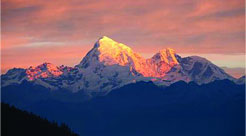The Mountains We Have Never Climbed
 Hundreds of mountains have yet to be explored, finds Rachel Nuwer. Why are these peaks so difficult to scale?
Hundreds of mountains have yet to be explored, finds Rachel Nuwer. Why are these peaks so difficult to scale?
difficult face of an already-summitted mountain; the first to climb an existing route in winter; the first to ski down a mountain; and the first to reach the summit of a difficult peak without the assistance of ropes, anchors or bolts. Others have achieved fame by breaking a record speed for getting up and down a particular route. Being the first to climb a previously unclimbed mountain works, too.
Challenging list
“Unclimbed mountains or unclimbed routes are far and away the aspiration of all serious mountaineers,” says Hilaree O’Neill, a skier, mountaineer and athlete, and the first woman ever to scale two 8,000m (26,400ft) peaks in 24 hours. “Mountaineers – at least the ones I know – are all adventurers at heart, and an unclimbed mountain, route or inventive technique epitomises that basic adventurer ideal.”
Plus, she adds, “Without a doubt, we are also a very egomaniacal group and an unclimbed anything helps separate a climber from the herd.”
No one knows how many unclimbed mountains remain in the world, but they number at least in the hundreds, if not the thousands. They can be found all over, with multitudes in former Soviet countries and in Russia; in Antarctica; in northern India, Pakistan and Afghanistan; in Myanmar, Bhutan, Tibet and beyond. “There are infinitely more unclimbed peaks than there are climbed ones,” says Lindsay Griffin, chairman of the Mount Everest Foundation screening committee, who has climbed at least 65 previously unclimbed mountains himself, mostly in Central Asia and the Himalayas. “It’s a vast place, the world.”
Modern technology – like GPS and satellite phones – has allowed climbers to better plan their ascents (AFP/Getty Images)
Identifying those peaks and then verifying that they are indeed unclimbed, however, is a challenge unto itself. There is no definitive database for the climbing history of every mountain in the world, and decades-old records – when they exist – might not be digitised. “Young people today are used to getting everything off the internet, so they think if it’s not online, then it doesn’t exist,” Griffin says. “They forget that people climbed really well back in the 1970s.”
In other cases, records of first ascents might not be translated into English. This is a significant problem for historic Japanese records, and even today it can be difficult to find current reports in English about South Korean expeditions, Griffin says.
Even when records do exist, that does not mean they are legitimate. Before digital cameras and GPS trackers, verifying someone’s claim was challenging, as was investigating the possibility that a deceased climber had reached the summit before losing his or her life. “Did George Mallory and Andrew Irvine summit Everest in 1924? That’s a perfect example,” O’Neill says. “If you look at mountaineering history through the late 1990s, there are a lot of disputed first ascents.”
“Part of the nature of this is that you can never be too sure that you’re the first,” adds Tim Moss, founder of The Next Challenge and author of How to Get to the North Pole.
Political problems
Today, it’s much easier to provide evidence a peak was climbed. But to achieve that success, climbers first have to gain access to the mountain. Many unclimbed mountains have yet to be scaled not because the ascent itself is challenging, but because of logistics. Many are incredibly remote, while others occur in areas engulfed in political turmoil, or they are simply forbidden to climbers.
At 7,570m (24,981ft), for example, Gangkhar Puensum – the 40th highest mountain in the world – counts as the world’s highest unclimbed mountain. Located in Bhutan near the Tibetan border, the “awful but fascinating” mountain eluded several mountaineering teams who tried to climb it over the course of a decade. In 1994, the unconquered Ganghkar Puensum was closed to climbers, along with all other peaks in Bhutan higher than 6,000m (19,800ft) – reportedly out of respect for local spiritual beliefs. “The Bhutanese are very keen on protecting their own people,” Griffin says. “They just looked at what was going on in Nepal with Everest and decided that they’re not going to be part of that.”
Mount Everest was only officially climbed in 1953; but did an earlier expedition reach the top? (Getty Images/AFP)
Not ready to let Gangkhar Puensum get away, in 1998, a Japanese team attempted to climb the mountain by approaching it from Tibet (China claims that half the peak falls within its territory). But Bhutan protested, and the team had to abandon its bid under somewhat mysterious circumstances. As mountaineer Tamotsu Nakamura later wrote: “As I cannot disclose an inside story behind the sudden cancellation, I write only that the reason why the permit was withdrawn was because of a political issue with [the] Bhutan government.” Rather than go home empty-handed, Nakamura and his climbing partners turned to Liangkang Kangri (also known as Gangkhar Puensum North), a 7,441m (24,555ft) unclimbed peak that is firmly planted in Tibet. Although that effort was a success, it was a disappointing end to the trip. As Nakamura later wrote, “I regret that Liangkang Kangri is not an outstanding summit.”
The world’s second highest unclimbed mountain – Muchu Chhish, a 7,452m (24,591ft) peak in Pakistan – however, might be scaled this summer. Peter Thompson, a mountaineer based in Derbyshire, England, will depart for Muchu Chhish on 4 August. Thompson and his team, learning from others’ unsuccessful attempts at the mountain, have decided to tackle it by spending the night at 5,700m (18,810ft) rather than making one day-long push for the summit. “I don’t know what our chances of success are, though they’re probably not hugely great,” Thompson says. “But we’re going to try.”
Thompson, who has climbed eight previously unclimbed peaks in Pakistan, values the exploratory aspect. As such, he readily admits that he seeks the easiest, most direct route to the summit. This doesn’t mean unclimbed mountains can’t be dangerous or challenging, however. Accidents can happen on any mountain, but at least on heavily climbed peaks detailed information is available about potential hazards, such as Everest’s Khumbu icefall or Mount Washington’s unpredictable weather and hurricane-force winds. Knowing about these dangers ahead of time can help prepare for them. For first ascents, on the other hand, the risks are uncertain and can sometimes prove deadly. “You have to step into the unknown,” Griffin says. “So you never know what you’re going to come up against.”
Improving technology
Consider Joe Puryear, a top climber from Washington who built a reputation for making first ascents of difficult routes in Alaska and the Pacific Northwest. By the time he turned 30, he became “a mountaineer of such renown that companies sponsored him to crisscross western China and Nepal seeking out summits no human had ever touched,” according to the Seattle Times. In 2010, while attempting to scale Labuche Kang, an unclimbed mountain in Tibet, Puryear broke through a cornice, fatally plummeting some 450m (1,500ft) to the glacier below.
Unlike previously climbed mountains, virgin peaks have no pre-laid route. No ladders or ropes exist to help guide the way, and dead ends and unexpected obstacles can stall progress. While fatalities do sometimes occur on these vertical labyrinths, more often the expeditions simply end in failure. In 2003, for example, Moss attempted to scale an unclimbed peak in Kyrgyzstan with a few university buddies and “failed miserably.” Half way up the mountain, the team couldn’t find anywhere to put their tents so they had to dig a nine-inch platform into the snow and wait out the night “sitting bolt upright on that steep step, terrified of falling down.” To make matters worse, the situation was so precarious that they couldn’t safely melt snow for drinking water. When the sun finally came up, the dehydrated, exhausted climbers decided to call it a day.
When things do work out, however, the victory is something to be especially savoured. “It’s obviously a great feeling to reach the top of any mountain, whether there’s 1,000 people there or whether you’re the first,” says Moss, who has climbed two previously unclimbed peaks in the Russian Altai Mountains. “But for me, the idea of being the first person to put foot on a bit of land was quite special.”
There are hundreds – if not thousands – of unclimbed peaks around the world (Science Photo Library)
As climbing gear improves, more and more people have the chance to enjoy that special sense of accomplishment. Gear has become lighter, stronger, warmer and more efficient, which allows climbers to quickly traverse terrain that might have taken double or triple the time years earlier. Teams in the 1920s used hemp ropes and climbed in wool clothing and leather boots, and as recently as the 1970s, mountaineers still had to sew their own down coats because commercial versions did not exist. Today, companies like Gore-Texprovide waterproof, windproof clothes for any occasion, while leather boots have been replaced by triple-layered plastic ones that are half the weight. “Climbers did incredibly well in the 1920s,” says Eric Johnson, a medical consulting physician for Global Rescue, and an avid climber. “But all of these things have dramatically improved our ability to approach bigger peaks with less gear.”
Improvements in travel and navigation, too, have been a boon for opening up previously unclimbed mountains. The speed of travel is “paramount,” Johnson says, allowing mountaineers travelling from London or Seattle to reach the Himalayas in just a few days, compared to the three-to-four months that journey entailed just a century ago. Before the mountaineers undertake that journey, Google Earth allows them to zoom into unmapped valleys and along ridges, plotting a route ahead of time and getting an idea of what they might be in for. (Some mountaineers, however, might consider this cheating, Moss points out.) More accurate weather forecasts have also made a significant difference in improving safety and success rates. “Using a sat phone, you can call some weather guru in Switzerland and know extremely detailed weather for a mountain in the Hindu Kush, and therefore plan your summit attempt accordingly,” O’Neill says.
Reducing the risks
In addition to weather forecasts, communications has added a new layer of safety to climbing both familiar and unclimbed peaks. Cell signals are now available at Everest Base Camp, and satellite phones are increasingly affordable and dependable. Just 15 years ago, mountaineers who encountered a problem on Everest, for example, had to radio down to someone at base camp, who would then try to place a call on a satellite phone to seek help. Today, thanks to the Iridium satellite constellation and several others, satellite phones can connect from almost anywhere in the world, including on unclimbed mountains hundreds of miles from the nearest city. Those phones are also becoming more durable and able to resist problems caused by freezing temperatures and moisture.
Mountaineers’ safety will never be guaranteed, but these advances are reducing the risks and upping the odds that help can quickly be summoned should something go awry. And with the world becoming an increasingly small place, more people can stake out their own small claim to fame by climbing one of the hundreds of mountains currently awaiting exploration. Many in the 6,000-to-7,000m (19,800ft-to-23,100ft) range in the Himalayas, for example, haven’t been climbed yet simply because people tend to focus on the 8,000m (26,400ft) peaks. In addition, more and more mountains that were once off limits are now reachable, including 104 peaks recently opened in Nepal. It’s probably only a matter of time until those last unclimbed peaks are scaled.

















Recent Comments